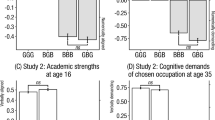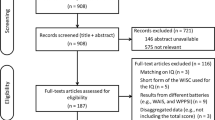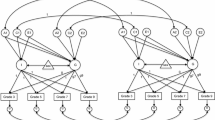Abstract
In order to compare the pattern of gender differences for cognitive measures in opposite-sex twin pairs to that in independent samples of twins from same-sex pairs, psychometric test data were obtained from four research-identified samples of children: (1) 96 pairs of opposite-sex fraternal twins in which at least one member of each pair is reading disabled; (2) 62 pairs of opposite-sex fraternal twins with no history of reading problems; (3) 167 males and 155 females from same-sex identical and same-sex fraternal twin pairs in which at least one member of each pair is reading disabled; and (4) a comparison sample of 126 males and 132 females from same-sex twin pairs with no history of reading problems. Results of multivariate analyses indicate that gender differences for cognitive measures are similar in twin pairs with and without reading disabilities. Moreover, a highly similar pattern of gender differences occurs for opposite-sex twin pairs who shared both prenatal and early postnatal influences and for independent samples of children from different families.
Similar content being viewed by others
References
Bradbury, P., Wright, S., Walker, C., and Ross, J. 1975. Performance on the WISC-R as a function of sex of E., sex of S., and age of S.Journal of Psychology 90:51–55.
Decker, S., and Vandenburg, S. 1985. Colorado twin study of reading disability. In D. Gray and J. Kavanagh (eds.),Biobehavioral Measures of Dyslexia. Parkton, MD: York Press.
DeFries, J., Olson, R., Pennington, B., and Smith, S. 1991. Colorado reading project: Past, present, and future.Learning Disabilities 2, 37–46.
DeFries, J., Plomin, R., Vandenburg, S., and Kuse, A. 1981. Parent-offspring resemblance for cognitive abilities in the Colorado Adoption Project: Biological, adoptive, and control parents and one-year old children.Intelligence 5, 245–77.
DeFries, J., Wadsworth, S., and Gillis, J. 1990. Gender differences in cognitive abilities of reading-disabled twins.Annals of Dyslexia 40, 216–28.
Denckla, M., and Rudel, R. 1976. Rapid ‘automatized’ naming of pictured objects, colors, letters, and numbers by normal children.Cortex 10, 186–202.
Dunn, L., and Markwardt, F. 1970.Examiner’s Manual: Peabody Individual Achievement Test. Circle Pines, MN: American Guidance Service.
Eno, L., and Woehlke, P. 1980. Diagnostic differences between educationally handicapped and learning disabled students.Psychology in the Schools 17, 469–73.
French, J., Elstrom, R., and Price, L. 1963.Manual for a Kit of Reference Tests for Cognitive Factors. Princeton: Educational Testing Service.
Hedges, L. V., and Nowell, A. 1995. Sex differences in mental test scores, variabiity, and numbers of high-scoring individuals.Science 269, 41–45.
Mayes, A., and Roberts, A. 1985. A study of WISC-R subtest scores of learning diabled students. Technical report, ERIC Document Reproduction Service No. ED262545.
Naiden, N. 1976. Ratio of boys to girls among disabled readers.The Reading Teacher 439–42.
Nichols, R., and Bilbro, W. 1966. The diagnosis of twin zygosity.Acta Genetica et Statistica Medica 16, 265–75.
Science Research Associates 1965.Primary Mental Abilities. Chicago: Science Research Associates.
Shaywitz, S., Shaywitz, B., Fletcher, J., and Escobar, M. 1990. Prevalence of reading disability in boys and girls.Journal of the American Medical Assocation 264, 998–1002.
Vogel, S. 1990. Gender differences in intelligence, language abilities, and academic achievement in students with learning disabilities: A review of the literature.Journal of Learning Disabilities 23, 44–52.
Wechsler, D. 1974.Examiner’s Manual: Wechsler Intelligence Scale for Children-Revised. New York: The Psychological Corporation.
Wechsler, D. 1981.Examiner’s Manual: Wechsler Adult Intelligence Scale-Revised. New York: The Psychological Corporation.
Author information
Authors and Affiliations
Corresponding author
Rights and permissions
About this article
Cite this article
Knopik, V.S., DeFries, J.C. & Alarcón, M. Gender differences in cognitive abilities of opposite-sex and same-sex twin pairs with reading disabilty. Annals of Dyslexia 46, 241–257 (1996). https://doi.org/10.1007/BF02648178
Issue Date:
DOI: https://doi.org/10.1007/BF02648178




